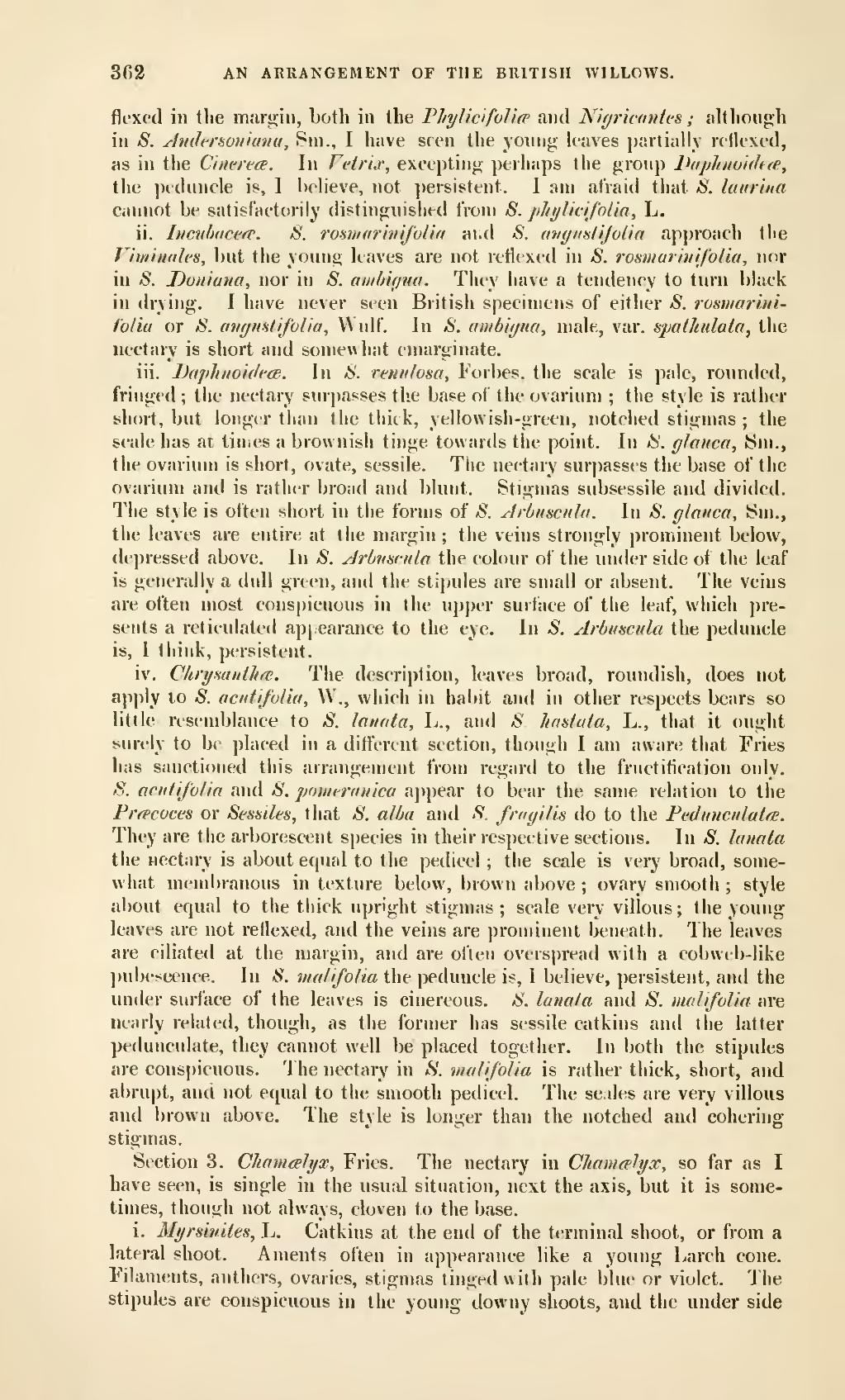363 AN ARRANGEMENT OF THE BRITISH WILLOWS.
flexed in the margin, both in the Phylicifoliff and Nigricantcs; altlioiigh ill S. Jnchrfioniana, Sm., I have seen the yoniig k-aves partially retlexed, as in the Cinereee. In Vetr'w, excepting- perhaps the group IkipJiituhha, the pednncle is, I believe, not persistent. I am afraid that *S'. laiirina Ciinnot be satisfactorily distinguished from S. p//j//icifolia, L.
ii. hicvhacefP. S. rosmorhiifolia and S. anyitslijoiia approach the Vimhniles, bnt the young leaves are not reflexed in S. rosniarhiifolia, nor in aS. Douiana, nor in S. mvbiqua. They have a tendency to turn black in (U'ving. I have never seen British specimens of either 8. romicirini- i'olia or S. ovgiifit [folia, \\ nlf. In S. amb'ujua, male, var. sjjcdhulata, the nectary is short and somewhat cmarginate.
iii. Daphiioidi'ce. In S. renitlosa, Forbes, the scale is pale, rounded, fringed; the nectary suipasses the base of the ovarium; the style is rather short, bnt longer tlian the thick, yellowish-green, notched stigmas; the scale has at times a brownish tinge towards the point. In IS. glauca, ISm., the ovarium is short, ovate, sessile. The nectary surpasses the base of the ovarium and is rather broad and blunt. Stigmas subsessile and divided. The style is often short in the forms of S. ArbuHcnla. In S. glauca, Sm., the leaves are entire at the margin; the veins strongly prominent below, depressed above. In S. Jrbnscnla the colour of the under side of the leaf is generally a dnll green, and the stipules are small or absent. The veins are often most conspicuous in the upper surface of the leaf, which pre- sents a reticulated appearance to the eye. In S. Arbuscula the peduncle is, 1 think, persistent.
iv. Ghrym)ith(V. The description, leaves broad, roundish, does not apply 10 S. acKtifulia, W., which in haiiit and in other respects bears so little resemblance to S. latiata, L., and S. Jinstuta, L., that it ought surely to be placed in a ditferent section, though I am aware that Fries has sanctioned this arrangement from regard to the fructification only. 8. aciitifolia and S. pomeranica a])pear to bear the same relation to the PrcBcoces or SessUes, that S. alba and aS". fnigilis do to the Pedunculatfe. They are the arborescent species in their respective sections. In S. Janata the nectary is about efpiid to the pedicel; the scale is very broad, some- what membranous in texture below, brown above; ovary smooth; style about equal to the thick upright stigmas; scale very villous; the young leaves are not reflexed, and the veins are prominent beneath. The leaves are ciliated at the margin, and are often overspread with a cobweb-like jmbescence. In S. malifolia the peduncle is, I believe, persistent, and the under surface of the leaves is cinereous. <S'. lunala and *S'. mulifolia are nearly related, though, as the former has sessile catkins and the latter pedunculate, they cannot well be placed together. In both the stipules are conspicuous. The nectary in 8. malifolia is rather thick, short, and abrupt, and not equal to the smooth pedicel. The scales are very villous and brown above. The style is longer than the notched and cohering stigmas.
Section 3. Cliamcelyx, Fries. The nectary in ChanKelyx, so far as I have seen, is single in the usual situation, next the axis, but it is some- times, though not always, cloven to the base.
i. Myrunites, L. Catkins at the end of the terminal shoot, or from a lateral shoot. Aments often in appearance like a young Larch cone. Filaments, anthers, ovaries, stigmas tinged with pale blue or violet. The stipules are conspicuous in the young downy shoots, and the under side
�� �
